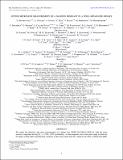Spitzer microlens measurement of a massive remnant in a well-separated binary
Abstract
We report the detection and mass measurement of a binary lens OGLE-2015-BLG-1285La,b, with the more massive component having M1 > 1.35 M⊙ (80% probability). A main-sequence star in this mass range is ruled out by limits on blue light, meaning that a primary in this mass range must be a neutron star (NS) or black hole (BH). The system has a projected separation r⊥ = 6.1 ± 0.4 AU and lies in the Galactic bulge. These measurements are based on the “microlens parallax” effect, i.e., comparing the microlensing light curve as seen from Spitzer, which lay at 1.25 AU projected from Earth, to the light curves from four ground-based surveys, three in the optical and one in the near-infrared. Future adaptive optics imaging of the companion by 30 m class telescopes will yield a much more accurate measurement of the primary mass. This discovery both opens the path and defines the challenges to detecting and characterizing BHs and NSs in wide binaries, with either dark or luminous companions. In particular, we discuss lessons that can be applied to future Spitzer and Kepler K2 microlensing parallax observations.
Citation
Shvartzvald , Y , Udalski , A , Gould , A , Han , C , Bozza , V , Friedmann , M , Hundertmark , M P G , Beichman , C , Bryden , G , Novati , S C , Carey , S , Fausnaugh , M , Gaudi , B S , Henderson , C B , Kerr , T , Pogge , R W , Varricatt , W , Wibking , B , Yee , J C , Zhu , W , Poleski , R , Pawlak , M , Szymański , M K , Skowron , J , Mróz , P , Kozłowski , S , Wyrzykowski , Ł , Pietrukowicz , P , Pietrzyński , G , Soszyński , I , Ulaczyk , K , Choi , J-Y , Park , H , Jung , Y K , Shin , I-G , Albrow , M D , Park , B-G , Kim , S-L , Lee , C-U , Cha , S-M , Kim , D-J , Lee , Y , Maoz , D , Kaspi , S , Street , R A , Tsapras , Y , Bachelet , E , Dominik , M , Bramich , D M , Horne , K D , Snodgrass , C , Steele , I A , Menzies , J , Figuera Jaimes , R J , Wambsganss , J , Schmidt , R , Cassan , A , Ranc , C , Mao , S , Dong , S , D’Ago , G , Scarpetta , G , Verma , P , Jørgensen , U G , Kerins , E & Skottfelt , J 2015 , ' Spitzer microlens measurement of a massive remnant in a well-separated binary ' , Astrophysical Journal , vol. 814 , no. 2 , pp. 111 . https://doi.org/10.1088/0004-637X/814/2/111
Publication
Astrophysical Journal
Status
Peer reviewed
ISSN
0004-637XType
Journal article
Description
Work by Y.S. was supported by an appointment to the NASA Postdoctoral Program at the Jet Propulsion Laboratory, administered by Oak Ridge Associated Universities through a contract with NASA. Work by J.C.Y., A.G., and S.C. was supported by JPL grant 1500811. Work by J.C.Y. was performed under contract with the California Institute of Technology (Caltech)/Jet Propulsion Laboratory (JPL) funded by NASA through the Sagan Fellowship Program executed by the NASA Exoplanet Science Institute. Work by C.H. was supported by Creative Research Initiative Program (2009-0081561) of National Research Foundation of Korea. L.W. acknowledges support from the Polish NCN Harmonia grant No. 2012/06/M/ST9/00172. D.M. and A.G. acknowledge support by a grant from the US Israel Binational Science Foundation. Work by D.M. is supported by the I-CORE program of the Israel Science Foundation and the Planning and Budgeting Committee. This publication was made possible by NPRP grant # X-019-1-006 from the Qatar National Research Fund (a member of Qatar Foundation). S.D. is supported by "the Strategic Priority Research Program—The Emergence of Cosmological Structures" of the Chinese Academy of Sciences (grant No. XDB09000000). Work by S.M. has been supported by the Strategic Priority Research Program "The Emergence of Cosmological Structures" of the Chinese Academy of Sciences Grant No. XDB09000000, and by the National Natural Science Foundation of China (NSFC) under grant numbers 11333003 and 11390372. M.P.G.H. acknowledges support from the Villum Foundation.Collections
Items in the St Andrews Research Repository are protected by copyright, with all rights reserved, unless otherwise indicated.

